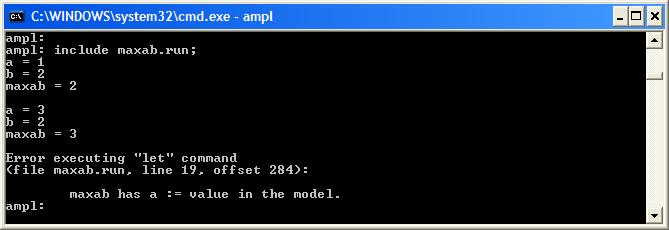
Difference: AMPLProcess (9 vs. 10)
Revision 102009-07-23 - CameronWalker
| Line: 1 to 1 | ||||||||
|---|---|---|---|---|---|---|---|---|
<-- Ready to Review - done - Lauren--> The AMPL Process | ||||||||
| Line: 29 to 29 | ||||||||
AMPL commands consist of statements in the AMPL syntax terminated with a ;.
Some examples include: | ||||||||
| Changed: | ||||||||
| < < | set INGREDIENTS; data;
display {i in INGREDIENTS} Percentage[i];
| |||||||
| > > | set INGREDIENTS; data; display {i in INGREDIENTS} Percentage[i]; | |||||||
If you forget the ;, then the ampl: prompt will be replaced by the ampl? prompt, indicating that your AMPL command has not been finished. You can finish your command or, if you are not sure how to finish it, type ;. AMPL will then interpret your AMPL command and display any problems. | ||||||||
| Line: 80 to 74 | ||||||||
Scripting in AMPLA script is a text file used to run a number of AMPL commands. It is useful when you may wish to run the same commands multiple times, possibly with slight editing changes. It is also useful for keeping track of what you have done, or if you may wish to rerun your models at a later date. Script files run in the model environment, and are usually named with a.run extension. It is good practice to get into the habit of using script files for your AMPL sessions. A typical script file should begin: | ||||||||
| Changed: | ||||||||
| < < | reset; model <modelname>.mod; data <dataname>.dat; . . .and you run this file using the include command. | |||||||
| > > | reset; model .mod; data .dat; . . .and you run this file using the include command. | |||||||

Setting Data DynamicallyAMPL allows you to set data "on the fly" using thelet keyword. If you have a set, parameter or variable as part of your model and have defined it using a data file (i.e., you did not use an expression to set a value for it), then you can change that structure on the fly with let. For example, | ||||||||
| Changed: | ||||||||
| < < | reset; model; param a; param b; param maxab := max(a, b); data; param a := 1; param b := 2; # Sets maxab = 2 display a, b, maxab; # Shifts AMPL back to the model environment let a := 3; # Sets a and maxab = 3 display a, b, maxab; let maxab := 4; # Syntax error, parameter defined by an expression display a, b, maxab; | |||||||
| > > | reset; model; param a; param b; param maxab := max(a, b); data; param a := 1; param b := 2; # Sets maxab = 2 display a, b, maxab; # Shifts AMPL back to the model environment let a := 3; # Sets a and maxab = 3 display a, b, maxab; let maxab := 4; # Syntax error, parameter defined by an expression display a, b, maxab; | |||||||
 | ||||||||
| Line: 138 to 103 | ||||||||
Running AMPL files | ||||||||
| Changed: | ||||||||
| < < | Once you have finished editing your AMPL files, you can run them by
| |||||||
| > > | Once you have finished editing your AMPL files, you can run them by:
| |||||||
| ||||||||
| Changed: | ||||||||
| < < |
| |||||||
| > > |
| |||||||
| Return to top | ||||||||
View topic | History: r10 < r9 < r8 < r7 | More topic actions...
Ideas, requests, problems regarding TWiki? Send feedback